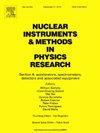Measurement of neutron spectral yield using Au foil based indigenous single sphere neutron spectrometer
IF 1.4
3区 物理与天体物理
Q3 INSTRUMENTS & INSTRUMENTATION
Nuclear Instruments & Methods in Physics Research Section A-accelerators Spectrometers Detectors and Associated Equipment
Pub Date : 2025-06-26
DOI:10.1016/j.nima.2025.170811
引用次数: 0
Abstract
In the present work, the neutron yield and energy distribution from the (21 MeV 1H + natBe) and (20 MeV 1H + natTa) systems were measured using an in-house developed high density poly-ethylene based moderation assembly and Au foils as the thermal neutron detectors. These detectors were placed at different layers of the spherical moderating assembly ensuring variable thermalisation of the fast neutrons at each location. The combined setup acts as a concentric single sphere neutron spectrometer (SSNS). The major advantage of using Au foil is its superior quantitative reproducibility and possibility of multiple spectral acquisitions considering significantly large half-life of 198Au (2.69 days). The response matrix of the moderation assembly along with the Au detectors placed at various depths in the moderation assembly has been evaluated using the FLUKA Monte Carlo simulations. Two separate unfolding approaches were used to construct the neutron spectra for both the reaction systems. Furthermore, an attempt has been made to study the effect of energy bins in the unfolded neutron spectral features and consequently on the resultant ambient dose equivalent values. For this purpose, a total of 5 different energy bins, viz. 31, 51, 71, 91 and 121 were tried out in the energy range between 0.1 MeV and 20 MeV for each unfolding method to generate the neutron spectra. The ambient dose equivalent estimates were arrived with the energy dependent neutron dose conversion coefficients and the estimated fluence spectra.
基于金箔的国产单球中介仪测量中子谱产率
在本工作中,使用内部开发的高密度聚乙烯基节制组件和金箔作为热中子探测器,测量了(21 MeV 1H + natBe)和(20 MeV 1H + natTa)系统的中子产率和能量分布。这些探测器被放置在球形减速装置的不同层,以确保在每个位置快中子的不同热化。该组合装置相当于一个同心单球中子星(SSNS)。考虑到198Au的半衰期(2.69天)很大,使用Au箔的主要优点是其优越的定量再现性和多重光谱采集的可能性。利用FLUKA蒙特卡罗模拟计算了调节装置的响应矩阵以及放置在调节装置中不同深度的Au探测器。两种不同的展开方法分别用于构建两种反应体系的中子谱。此外,还尝试研究了能量仓对展开中子谱特征的影响,从而对所得到的环境剂量当量的影响。为此,在0.1 MeV至20 MeV的能量范围内,对每种展开方法分别进行了31、51、71、91和121 5个不同能量仓的试验,以生成中子能谱。利用能量依赖的中子剂量转换系数和估算的通量谱,得到了环境剂量当量估计。
本文章由计算机程序翻译,如有差异,请以英文原文为准。
求助全文
约1分钟内获得全文
求助全文
来源期刊
CiteScore
3.20
自引率
21.40%
发文量
787
审稿时长
1 months
期刊介绍:
Section A of Nuclear Instruments and Methods in Physics Research publishes papers on design, manufacturing and performance of scientific instruments with an emphasis on large scale facilities. This includes the development of particle accelerators, ion sources, beam transport systems and target arrangements as well as the use of secondary phenomena such as synchrotron radiation and free electron lasers. It also includes all types of instrumentation for the detection and spectrometry of radiations from high energy processes and nuclear decays, as well as instrumentation for experiments at nuclear reactors. Specialized electronics for nuclear and other types of spectrometry as well as computerization of measurements and control systems in this area also find their place in the A section.
Theoretical as well as experimental papers are accepted.

 求助内容:
求助内容: 应助结果提醒方式:
应助结果提醒方式:


